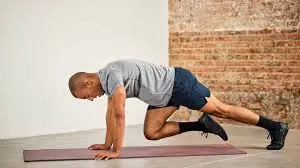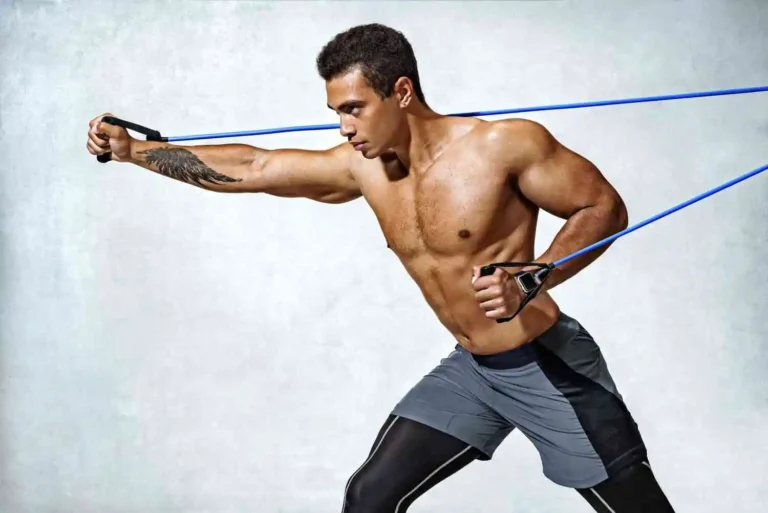Mountain Climber Exercise
The Mountain Climber is a high-intensity, bodyweight exercise that combines core strengthening with cardiovascular conditioning. It involves a dynamic, running-like motion in a plank position, engaging multiple muscle groups, including the core, arms, legs, and shoulders.
This versatile exercise is ideal for improving endurance, agility, and functional fitness, making it a staple in many workout routines.
What is Mountain Climber Exercise?
Exercises for mountain climbers are an effective bodyweight workout that targets multiple muscle groups at once, improving blood flow, strength, flexibility, balance, agility, and coordination. One type of high-intensity interval training (HIIT) exercise is mountain climbing.
Because mountain climber exercises are complicated and target multiple muscle groups across your body, they are a great way to improve your arms, back, shoulders, core, and legs.
Your heart rate rises when you use multiple muscles at once, increasing the number of calories you burn. Therefore, this is a great exercise if you want to increase the definition of your abdominal area.
Mountain climbers can also improve your overall stability, joint mobility, and reaction time. The good news is that you don’t need to walk to the nearest summit to try this exercise! You don’t need any equipment because you can perform mountain climbing at any time and anywhere. Read on for our top tips and a thorough how-to for executing a mountain climb.
Which muscles are used in Mountain Climber Exercise?
- Rectus abdominis
- Obliques
- Transverse abdominis
- Deltoids
- Rotator cuff muscles
- Triceps
- Pectoralis major
- Hamstrings
- Glutes
- Quadriceps
- Calves
- Hip Flexors muscles
What are the Benefits of Mountain Climber Exercise?
- Cardiovascular Health: They raise your heart rate considerably, which increases calorie burning and cardiovascular endurance.
- Core Strength: A core-intensive workout that strengthens your lower back, obliques, and abs is the mountain climber.
- Full-Body Engagement: The legs, arms, shoulders, and chest are among the many muscular groups that are worked concurrently by this dynamic workout.
- Agility and Coordination: The rapid, alternating motions improve balance, agility, and coordination.
- Versatility: By changing the pace and duration, mountain climbers can be tailored to different levels of fitness.
- Weight Loss Support: Burns calories rapidly, aiding in fat loss and improving metabolism.
- Convenience: They are perfect for at-home workouts because they require little equipment and can be done anywhere.
How to perform Mountain Climber Exercise properly?
- Bend low to your hands and knees. Align your hands shoulder-distance out, with your shoulders over your wrists.
- To properly support the shoulders and upper body, spread your fingers apart and press the space between your thumb and index finger into the ground.
- Return to a high plank position with your right leg to keep your torso straight from heel to head.
- Step your left leg back to meet your right leg in the plank position.
- Verify the neutrality of your spine.
- Continue to feel as though you are pressing your hands into the ground and raising the area between your shoulder blades a little bit toward the ceiling. Your serratus anterior will be better activated if you do this.
- Look at a location on the floor directly in front of your hands, keeping your neck in alignment with your spine.
- Using your abdominal muscles, bend your right leg toward your chest and then step it back into the plank position.
- Bring your left leg close to your chest, then step it back to repeat.
- This is one mountain climber repetition.
Mountain Climber Exercise Video:
Which Mountain Climber Exercise Types Are There?
If you’re looking for something different from the typical mountain climber exercise, there are a number of methods to make the movement more challenging, less challenging, or simply more creative.
Incline modification
- To create an incline plank position, place your hands on a bench or step and perform the exercise as previously mentioned.
- This option puts less strain on your wrists and upper body, which is advantageous if you need to think about being hurt or want to progressively build up your strength in these areas.
- Being on an incline is also a little easier for those who find it difficult to maintain good form in a plank stance.
- If you are higher off the ground than if your hands are on the ground, your abdominal muscles will be engaged less.
- Other studies, however, show that the lumbar and ab muscles are more activated by movements like mountain climbers, which combine core activity with the recruitment of the glute and deltoid muscles, than by more traditional ab exercises like crunches.
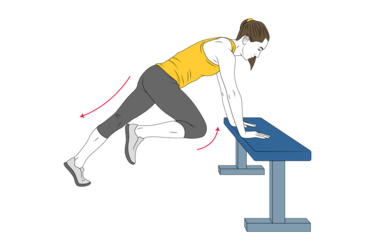
Pushup handles modification
- To change the location of your hands and grip, hold onto the pushup handles.
- This lessens the amount of wrist extension that occurs while your hands are flat on the floor.
- It might feel more comfortable if you have wrist or finger issues.
Twist variation
- In the plank position, pull your right knee close to your left upper arm and your left knee toward your right upper arm, rather than bringing both knees straight up toward your chest.
- Keep your shoulders level with your wrists. Your waist will twist if your arms and upper body remain steady.
- In contrast to regular mountain climbers, incorporating rotation helps to improve your torso’s oblique muscles.
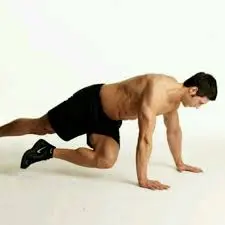
Semicircle variation
- Maintaining your hands fixed in a plank posture, move your right leg to the outside of your chest, near your right elbow, and back to the starting pose.
- Next, form a semicircle by drawing your left leg to the outside of your left elbow.
- The quadratus lumborum and other back muscles are worked in addition to the oblique muscles of the abdomen with this fun variation that adds side bending to traditional mountain climbers.
Decline plank progression
- Position both feet up on a bench to create a decline plank.
- This progression is a great option if you want to develop your upper body because it puts additional strain on your shoulders.
Burpee or pushup progression
- To stay motivated, it’s a great idea to mix mountain climbers with other exercises like pushups and burpees, especially as you become used to them.
- Try performing two pushups or burpee reps after four mountain climber repeats as part of a HIIT program. Then, repeat the pattern for 30 seconds.
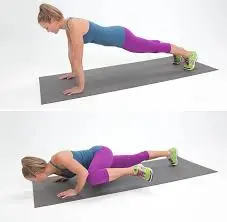
How Can Your Workout Incorporate Mountain Climber Exercise?
There are numerous ways to incorporate the mountain climber, a very adaptable bodyweight exercise, into your routine. A knee drive with both legs counts as one repetition, and you can repeat the exercise for a certain number of repetitions. It might be better for you to hang out with mountain climbers.
After setting a timer for six minutes, work in rounds of ten seconds of rest and twenty seconds of labor, being cautious to exert maximum effort throughout each work phase. Even longer labor durations, like 30 seconds or more, are possible. Just be careful to keep your hips below your shoulders, your core strong, and your posture robust.
Instructions for Mountain Climber Exercise
- The best choice for hand comfort and avoiding slippage is to use an exercise mat.
- In terms of technical challenges, it is common for mountain climbers to form a downward dog or triangle with their hips raised too high.
- Furthermore, your head would sag too much in this posture.
- However, there are times when your hips may drop too low, which can lead to an abnormal arch in your lower back.
- Maintain your hips in line with your shoulders, your head in line with the rest of your spine, and your gaze angled slightly forward toward a location on the floor in front of you.
- You will gain from strengthening both your upper body and abdominal muscles in this way.
What is a Common Mistake you can’t make while Mountain climbers exercise?
A few typical mistakes can reduce a mountain climber’s effectiveness or perhaps put them in danger.
Bouncing on Your Toes
Exercise with good form is essential for both injury prevention and maximum efficacy. For instance, bouncing on your toes while doing the maneuver is a classic rookie error made by mountain climbers. Although it may seem like a more difficult workout, the bouncing really uses your core muscles less. Maintaining proper form can be aided by wearing appropriate footwear, such as CrossFit shoes.
Avoid Putting Your Toes on the Floor
The failure to finish the movement by allowing your toes to contact the ground as you draw your knees into your chest is another form of error that mountain climbers may make, particularly as they accelerate up. You run the risk of getting hurt and won’t be able to benefit fully from the mountain climbers if your toes are off the ground.
Shifting Your Weight Back
It’s simple to allow your weight to shift back so your bottom is up in the air during a down-dog if you’re not accustomed to mountain climbers. Make sure your shoulders are over your wrists and your weight is evenly distributed.
What are the Safety and Precautions for Mountain Climber Exercise?
For mountain climbers of all skill levels, the ability to assume and maintain the proper plank stance is essential. This entails ensuring that:
- Straight down from your shoulders, you are holding your arms and hands.
- Instead of being arched or bent, your back is flat and straight.
- Your hips shouldn’t be raised, nor should your butt be in the air.
- To ensure a successful and safe move, review the proper planking form. Performing a plank with poor form will drastically reduce the benefits of employing mountain climbers in your training regimen and raise your risk of injury.
- You should avoid mountain climbers if you have pelvic or shoulder problems or instabilities.
- Even though mountain climbers are a great way to strengthen your knees, if you have had surgery or need it (for example, to replace a joint damaged by arthritis or repair a sports-related injury), you should see your doctor or physical therapist before adding them to your regimen.
- If you recently became pregnant or had abdominal surgery, you may develop diastasis recti, a condition where the muscles in your abdomen separate. Until this issue completely heals, you should avoid undertaking any mountain climbers or core workouts.
Summary
- Mountain climbing is a workout that can be scaled to many different levels.
- Start by doing them slowly and deliberately, marching with your legs while being mindful of your form.
- After that, progress to jogging with your legs, adding mountain climbers and progressively harder variations to your regular HIIT regimen to strengthen your heart.
FAQs
What are the benefits of mountain climbers’ exercise?
Mountain climbers are a great way to improve your arms, back, shoulders, core, and legs because they are a complex exercise that works for many different muscle groups throughout your body. Using several muscles at once also raises your heart rate, which increases your calorie expenditure.
Do mountain climbers give you abs?
Miriam Fried, a personal trainer based in New York City and the founder of MF Strong, told Insider that when done properly, mountain climbers and other plank variations can be more effective ab exercises than crunches.
Can mountain climbers burn fat?
A hard workout that increases heart rate and burns calories is the mountain climber. It’s the ideal workout to shed that stubborn belly fat and show off your abs because it also works your core. Place yourself in a typical pushup position to perform a mountain climber.
How many mountain climbers per day?
As part of a program that emphasizes developing muscle strength and fitness, do two to three sets of ten to fifteen slow, controlled repetitions.
References:
- Goriya, D. (2024, November 20). Mountain Climber Exercise: a Core-Strengthening Powerhouse. Physical Therapy Treatment and Exercise. https://physical-therapy.us/mountain-climber-exercise/
- Cpt, P. W. (2024a, May 19). Learn to master mountain climbers. Verywell Fit. https://www.verywellfit.com/mountain-climbers-exercise-3966947
- Nasm, B. W., & CSCS, E. S. (2022, April 13). How to do mountain climbers the right way. Men’s Health. https://www.menshealth.com/fitness/a28775134/mountain-climber-abs-workout/
- How to do Mountain Climbers. (n.d.). PureGym. https://www.puregym.com/exercises/full-body/mountain-climbers/
- Ba, G. R. (2022, March 10). What muscles do mountain climbers work? Healthline. https://www.healthline.com/health/fitness/what-do-mountain-climbers-work#how-to-do-them

